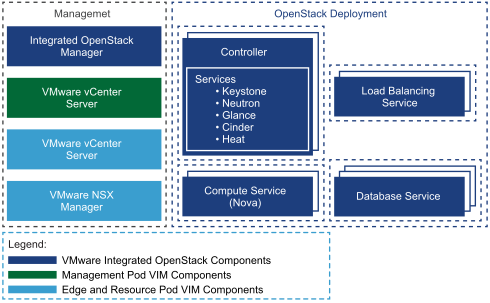The VMware Integrated OpenStack Management Server (OMS) connects to the vCenter Server instance that manages the Management pod. OMS uses a VM template to rapidly deploy, administer and perform day 2 management operations of the VMware Integrated OpenStack management plane components that are deployed in the Management pod. OMS is used to instantiate either the two-pod or three-pod deployment of the VMware Integrated OpenStack management plane.
VMware Integrated OpenStack connects to the second vCenter Server instance that manages the collapsed Edge/Resource pod. This vCenter Server instance is responsible for storage and compute resources. VMware Integrated OpenStack is also connected to the NSX Manager instance that is associated with the Edge/Resource pod networking.

The VMware Integrated OpenStack management plane is deployed with redundancy for all the VMware Integrated OpenStack management components ensuring that there is no single point of failure. Even though this requires higher resources to be made available in the Management pod, it offers the best configuration for high availability and is the recommended topology for production environments. OMS can also be used to deploy a compact instance of VMware Integrated OpenStack with a significantly smaller resource requirement, however, this topology is not as highly available or scalable as the full deployment
OMS deploys all the necessary components for a scalable and highly available VMware Integrated OpenStack deployment, this includes clustered databases, controllers and VMware Integrated OpenStack load balancers. All the management components have connectivity to each other through a dedicated management network.

VMware Integrated OpenStack is closely integrated with NSX for vSphere, which provides tenants with more features and capabilities for managing their VNF networking needs directly from within the Horizon interface and APIs. With VMware vCloud NFV OpenStack Edition, all the building blocks for creating secure multitenant VNF networks are in the hands of the tenant. These network services include firewalling, network address translation (NAT), static and dynamic routing, and load balancing. Tenants can provision VXLAN backed logical switches for East-West VNF component connectivity. At the same time, they can deploy NSX ESGs for North-South traffic, as required when connecting to other tenants or to external networks. With this integration, CSPs spend fewer administrative resources configuring and setting up VNFs, reducing the cost of managing the platform.